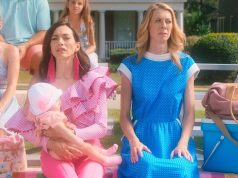They’re remaking foreign films into English-language ones so fast now that they’ve lapped themselves: “The Grudge” opens in theaters while “Ju-On: The Grudge,” which it is based on, is still playing. I saw them within a week of each other (I saw the American one first, in case you’re curious), and I quickly realized it was useless to try to write two reviews when they are essentially the same movie. Of course, “Chasing Liberty” and “First Daughter” were essentially the same movie, too, and I managed to review both of them, so maybe I’m just lazy. You be the judge.
Rarely, if ever, has a foreign film been remade so closely. Takashi Shimizu directed both versions, some of the dialogue is the same (though translated into English, of course), the plots are nearly identical. Shimizu even uses the same sets and actors in several instances.
All of which begs the question, why remake it at all? The answer, of course, is that with rare, martial-arts-oriented exceptions, subtitled foreign films do not fare well in American theaters. “Ju-On” would have topped out at around $50 million, at the very most, even if it were released on 3,000 screens; “The Grudge” will gross four times that, all because the characters speak English rather than Japanese.
“Ju-On” does it more episodically, with chapter titles declaring the name of that segment’s main character, but both films tell the story of a house in Tokyo where a man once killed his wife and possibly his son and possibly himself. Now, several years later, all who enter the house seem to encounter a curse of some kind, insofar as they are soon beset by evil forces, haunted by the specters of the aforesaid wife and son, and eventually murdered.
The story is told out of sequence, jumping from past to present at various key moments, usually just as a person is being killed. This method mainly serves to make us think this ISN’T just a regular ol’ story about a haunted house in which all occupants die one by one. It’s particularly disorienting in the Japanese version, where unfortunately Shimizu cast actresses who look alike to play the various leads — same hair style and length, same height, etc. I’m not saying ALL Japanese women look alike; I’m just saying the ones in “Ju-On” do. If you don’t keep track of everyone’s names, you’re lost.
The American version streamlines it a bit, allowing for more focus on Sarah Michelle Geller’s character, an American girl volunteering at a care center while her boyfriend (Jason Behr) goes to school. Gone are the original’s subplots dealing with a detective who investigated previous murders and whose daughter came under the evil power of the house, too. I rather like that thread, as it shows the far-reaching power of the house, stretching across several years and affecting everyone even tangentially connected to it. The Geller version feels more compact, less broad in its scope, more like a traditional Hollywood thriller.
Both versions are very big on the jump-scares, where things occur suddenly and make you wet yourself. The appearance of the creepy androgynous Japanese boy (Yuya Ozeki) and his forlorn mother (Takako Fuji) is always a startling development, especially when either of them makes their weird bullfrog-croaking sound that is generally a harbinger of death. (The characters are played by the same actors in both films, which makes me wonder if they’ll become typecast as creepy Japanese people who show up and kill you. Is there a big market for that?)
In fact, there is nearly enough atmosphere and general creepiness to make you forget that neither film really adds up to anything. We learn very early on that something awful happened in this house and now everyone who enters will die. Then, at the end of the film, we discover that, um, something awful happened in this house and now everyone who enters will die. There is no twist, no “reveal,” no tying up of all the clues to make us see the clever plotting that was lurking beneath the surface all along. It’s disappointing to realize that the film truly IS nothing more than a series of people dying, albeit in armrest-gripping fashion. It’s good for a lark, but we usually like our thrillers to have something more to them.
The Grudge: C
1 hr., 36 min.
PG-13 for a little mild sexuality, some profanity, lots of scary stuff, some blood
Ju-On: The Grudge (Japanese): B-
1 hr., 31 min.; in Japanese with subtitles
R for “some disturbing images,” including some blood and violence; should have been PG-13
B- (1 hr., 31 min.; Japanese with subtitles; )





